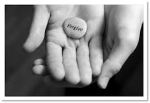 You’ve probably heard by now, that being present stills the mind and all its turbulence.
You’ve probably heard by now, that being present stills the mind and all its turbulence.
But…the greatest block to this state of presence is our mental turbulence.
This is like being told you need experience to get the job, but how are you supposed to get experience if they won’t give you the job!
This is a fine predicament.
The answer to this pickle comes in the form of a question:
Have you ever been so engrossed in a task that presence was inevitable?
Tasks of a physical nature are especially adept in bringing us here, since the mind, left to its own devices, soon falls into its customary habits. And we all know, the mind likes to swing.
The physical Yoga postures known as asana do this for us.
Just about all activities that require our active engagement do this for us (watching TV generally doesn’t do it).
Sometimes Yoga instructors will even tell you to find your edge. This is because when we are at our edge, we receive instantaneous feedback that enables us to make corrections as needed.
As it happens, this is where transformation happens.
As with the concept of flow, this is because when we are at our edge, we are at a point where the challenge slightly supersedes our skill level (clearly, if the challenges are too high, this will cause stress and if too low, boredom may result—but this is a slight digression).
When the balance between challenge and skill is just right, presence is obligatory, often at the risk of personal harm; for example, in a balancing pose, or more dramatically, while hanging from a rope on the edge of a cliff (Some of us, myself included, would rather hang out in a balancing pose rather than on the side of a mountain, even though we like mountains very much).
So, it follows that being comfortable is not the best condition for improvement and growth.
Why does transformation happen here?
Because loss of self-consciousness happens in this state of total engrossment.
Self-consciousness is, not surprisingly, what all the spiritual traditions speak of as enlightenment, albeit in myriad ways, e.g., as the loss of the small self, or, as the merging of finite with the infinite, etc.
Now, as it happens, these same conditions also entrain intuition, something we talk about often, in Kundalini Yoga. Intuitive awareness is a form of knowing that goes beyond the ordinary ways of picking up information, in other words, beyond the words and ideas, concepts and data that are the usual ways of exchanging and receiving knowledge.
One of the reasons why this vivid state of undivided presence cultivates intuition is because in this way, the whole body is alive with awareness. In this state, the energetic flow within us is flowing and unobstructed. In fact, as my own teacher used to remind us, when we are aware that we are breathing, we actually take in more prana. Same amount of oxygen, but more prana (or as the Chinese would say, more ch’i). This means our whole body becomes a receiver and transmission instrument (our mind is not localized in the head).
Prana is energy and if everything is energy, as Einstein said, then we merge into everything as just another aspect of this flowing energetic awareness, when we enter this state. The Yogis call it…well, the Yogis call it Yoga. Merging with divine awareness. Or, merging in divine awareness.
The only thing that holds us back from this state, is our own mental stuff and our attachments to that stuff. Flexibility moves us back to center, which is to say, back to everything and everywhere, and so, in this way, the best definition of non-attachment is actually…flexibility.
*Image courtesy of www.easternhealingcenter.com













